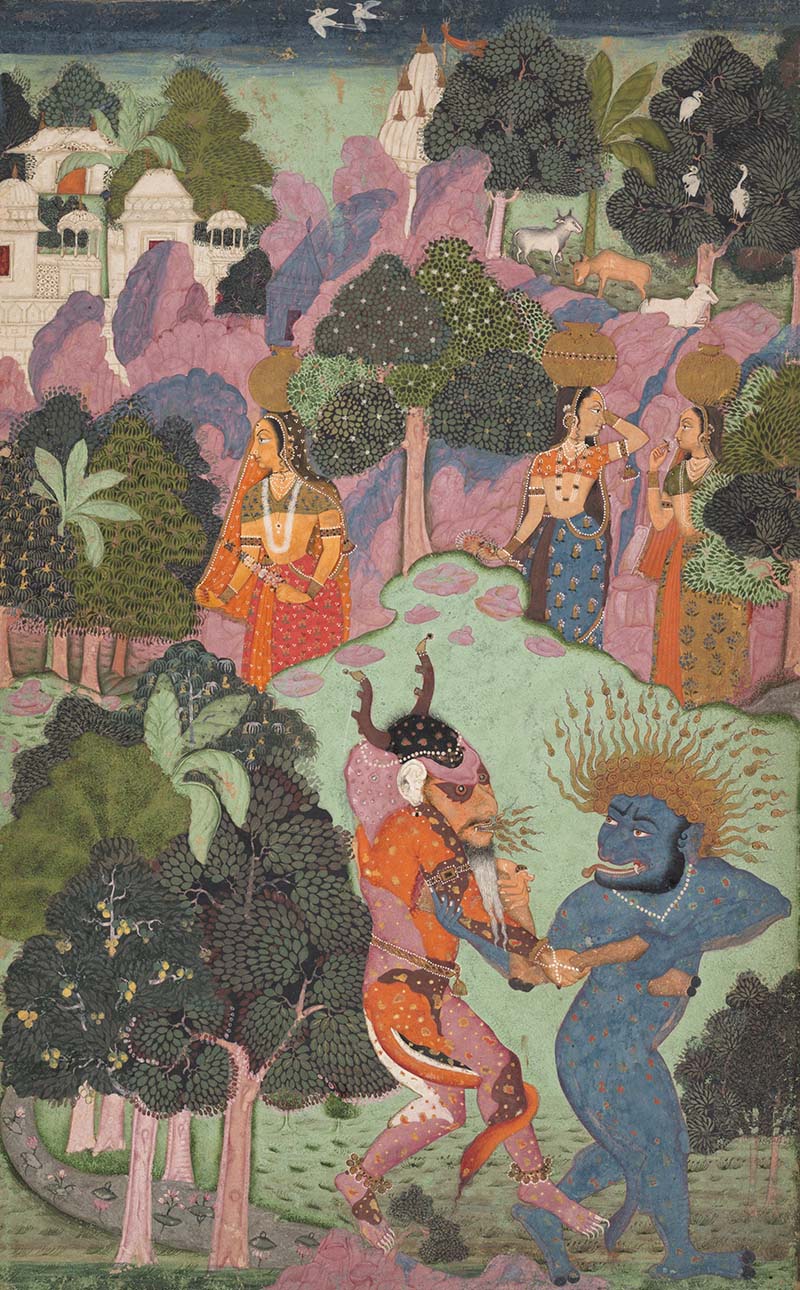ARTICLE
Rajasthani Manuscript Painting
Rajput rulers also formed close alliances with the Mughal dynasty which gained centralised power in the Indian subcontinent from the mid-sixteenth century onwards. Alongside other social and cultural exchanges between the Mughal and Rajput courts, the influence of Mughal miniature painting became increasingly pronounced in the manuscript traditions in Rajasthan and beyond. The kitabkhanas — libraries and book-making workshops — of the Mughal court invited artists from all over the empire, and beyond. Among them were a large number of specialists, including calligraphers, colourists and painters, working together in a highly organised environment to produce lavish manuscripts. In the Rajput context, however, manuscript-painting teams often simply comprised the extended families of painters, who were sometimes present at court and at other times worked from their family homes in the small towns and cities of the kingdom. At the same time, the smaller Rajput principalities in central India also carried forward the longstanding traditions of the Malwa school of painting, after the fall of the Malwa kingdom’s capital Mandu in the second half of the sixteenth century. These diverse influences were amalgamated in various ways to give birth to a series of regional styles.
In the sixteenth century, the Mughal techniques of naturalism in landscape and facial features, spatial depth and perspective, were absorbed to differing degrees in these courts and co-existed alongside their own traditional styles. The themes of the manuscripts from this period were diverse, encompassing Hindu religious texts such as the Bhagavata Purana, epics such as the Ramayana and Mahabharata, as well as legends and stories about local folk heroes. As Vaishnavism took hold of sixteenth-century Rajasthan, works about the life of Krishna, in particular, were produced across the various royal courts. Poetical works such as Rasamanjari, Rasikapriya were also commissioned, as were devotional works like the Gitagovinda and Sur Sagar.
Each Rajput principality had its own legacy and style of manuscript painting, with patronage and production not always limited to royal workshops. In Marwar, for example, a Meghaduta manuscript was commissioned by lay patrons in 1699, showing stylistic similarities with a traditional Ragamala series dating back to 1624. At Mewar, which hosted another prominent school of miniature painting, the earliest manuscript, Chawand Ragamala, dates back to 1605. It is one of several notable works produced by the court’s workshop during the first half of the seventeenth century, including the Mewar Ramayana (1649–53).
In the seventeenth century, the style of the Bikaner school continued to parallel the Mughal artistic style of the time. However, by the second half of the century, the Mughal workshops suffered a decline and Bikaner’s local painting tradition re-emerged and gained prominence, as evidenced by a Rasikapriya series and Bhagavata Purana dating to this time. It was during the same period that manuscript painting was also flourishing in the workshops or chitrashalas of Bundi and Kota. The former is notable for its use of elements from both the Mughal and the Deccani schools. The latter, after its separation from Bundi, established its own painting tradition, which included detailed depictions of landscapes and hunting scenes in addition to devotional works.
The apogee of the Kishangarh school, meanwhile, came in the first half of the eighteenth century, characterised by devotional paintings of Radha and Krishna. These paintings, primarily executed by the master artist Nihal Chand, were based on the Bhagavata Purana, the Gita Govinda and the poems of Savant Singh, then-ruler of Kishangarh. In the court of Amber at Jaipur as well, court painting gained prominence in the eighteenth century, with several manuscripts produced under the royal patronage of its ruler Sawai Pratap Singh, including a Ragamala series and a Rasikapriya series.
Like many manuscript painting traditions in the subcontinent, the administrative and economic policies of the British government in the nineteenth century led to a decline in patronage as the wealth of most of the smaller courts was reduced. Coupled with the arrival of photography, which attracted the interest of royal patrons, and new avenues of employment for artists, such as Company paintings, Rajasthani and other miniature painting traditions faded away by the late nineteenth century.
Bibliography
Beach, Milo Cleveland. Mughal and Rajput Painting. The New Cambridge History of India. Cambridge: Cambridge University Press, 1992.
Behrendt, Kurt. “Poetic Allusions in the Rajput and Pahari Painting of India.” Heilbrunn Timeline of Art History: Essays. October 2016. The Metropolitan Museum of Art. Accessed March 22, 2024. https://www.metmuseum.org/toah/hd/rajp/hd_rajp.htm.
Chakraverty, Anjan. Indian Miniature Painting. New Delhi: Roli Books, 2005.
Desai, Vishakha N. “Painting and Politics in Seventeenth-Century North India: Mewar, Bikaner, and the Mughal Court.” Art Journal 49, no. 4 (1990): 370–78. https://doi.org/10.2307/777138.
Glynn, Catherine. “Evidence of Royal Painting for the Amber Court.” Artibus Asiae 56, no. 1/2 (1996): 67–93. https://doi.org/10.2307/3250105.
Goetz, Herman. “General Surveys of Schools of Rajasthani Painting: Marwar (with some paintings from Jodhpur in the collection of Kumar Sangram Singh).” Marg 11, no. 2 (March 1958): 42–49.
Guy, John, and Jorrit Britschgi. Wonder of the Age: Master Painters of India, 1100-1900. New York: The Metropolitan Museum of Art, 2011. Published in conjunction with an exhibition of the same title presented at The Metropolitan Museum of Art, September 28, 2011–January 8, 2012.
Sharma, O. P. Indian Miniature Painting. Brussels: Bibliothèque Royale Albert 1er, 1974.
Topsfield, Andrew. “Court Painting at Udaipur: Art under the Patronage of the Maharanas of Mewar.” Supplementum 44. Zurich: Artibus Asiae Publishers, 2002. http://www.jstor.org/stable/1522717.








